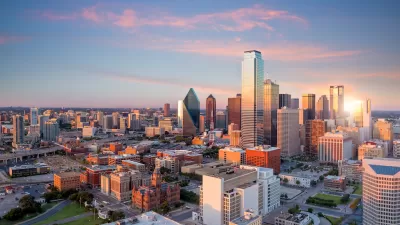Eager for downtown development, Kansas City signed a deal subsidizing Cordish Companies to the tune of $295 million. The rejuvenated district should be self-sustaining. So why is the city still funding Cordish?

In a Next City feature, Sandy Smith tells the story of a desolate downtown and a plan to partner with big developers to make it a place worth visiting.
In 2006, Kansas City issued close to $300 million in bonds to help Cordish Companies build an entertainment district. "Occupying an entire city block with restaurants, bars, nightspots and shops, KC Live [...] would have been unimaginable in Kansas City 15 years ago."
Two years later, the recession hit. Without expected tax revenues, city officials realized they had made a bad bargain. "Kansas City Mayor Sly James has since said that City Hall won't again make deals like the one it made with Cordish, yet the city remains beholden to the agreement in ways that are still emerging."
Smith writes, "But at what point should cities make this decision to stop subsidizing for-profit development? And how do they know when enough is enough? That's the question being asked in Kansas City and in cities around the nation as downtowns bounce back from years of abandonment only to find that developers still expect the aid they were receiving when downtowns were far less profitable places to be."
Part of the problem is historical: "'Urban leaders still tend to overpay for development because they internalized low civic self-esteem bred by decades of being told they were too polluted, too dangerous, or too school-deficient to attract investment,' says Greg LeRoy, executive director of Good Jobs First [...]"
Cities can reap great benefits from redeveloped downtowns. "But in a moment of increasing urban inequality and shrinking government coffers, is it government's job to subsidize amenities for people renting apartments in high-end towers?"
FULL STORY: The $295 Million Mall Taxpayers Bought Kansas City

Alabama: Trump Terminates Settlements for Black Communities Harmed By Raw Sewage
Trump deemed the landmark civil rights agreement “illegal DEI and environmental justice policy.”

Planetizen Federal Action Tracker
A weekly monitor of how Trump’s orders and actions are impacting planners and planning in America.

Why Should We Subsidize Public Transportation?
Many public transit agencies face financial stress due to rising costs, declining fare revenue, and declining subsidies. Transit advocates must provide a strong business case for increasing public transit funding.

Understanding Road Diets
An explainer from Momentum highlights the advantages of reducing vehicle lanes in favor of more bike, transit, and pedestrian infrastructure.

New California Law Regulates Warehouse Pollution
A new law tightens building and emissions regulations for large distribution warehouses to mitigate air pollution and traffic in surrounding communities.

Phoenix Announces Opening Date for Light Rail Extension
The South Central extension will connect South Phoenix to downtown and other major hubs starting on June 7.
Urban Design for Planners 1: Software Tools
This six-course series explores essential urban design concepts using open source software and equips planners with the tools they need to participate fully in the urban design process.
Planning for Universal Design
Learn the tools for implementing Universal Design in planning regulations.
Caltrans
Smith Gee Studio
Institute for Housing and Urban Development Studies (IHS)
City of Grandview
Harvard GSD Executive Education
Toledo-Lucas County Plan Commissions
Salt Lake City
NYU Wagner Graduate School of Public Service




























